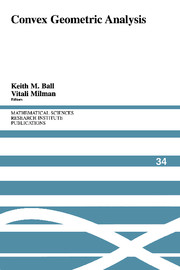Book contents
- Frontmatter
- Contents
- Introduction: The Convex Geometry and Geometric Analysis Program MSRI, Spring 1996
- Msri Program Seminars
- Integrals of Smooth and Analytic Functions over Minkowski's Sums of Convex Sets
- Localization Technique on the Sphere and the Gromov-Milman Theorem on the Concentration Phenomenon on Uniformly Convex Sphere
- Geometric Inequalities in Option Pricing
- Random Points in Isotropic Convex Sets
- Threshold Intervals under Group Symmetries
- On a Generalization of the Busemann-Petty Problem
- Isotropic Constants of Schatten Class Spaces
- On the Stability of the Volume Radius
- Polytope Approximations of the Unit Ball of ℓnp
- A Remark about the Scalar-Plus-Compact Problem
- Another Low-Technology Estimate in Convex Geometry
- On the Equivalence Between Geometric and Arithmetic Means for Log-Concave Measures
- On the Constant in the Reverse Brunn-Minkowski Inequality for p-Convex Balls
- The Extension of the Finite-Dimensional Version of Krivine's Theorem to Quasi-Normed Spaces
- A Note on Gowers' Dichotomy Theorem
- An "Isomorphic" Version of Dvoretzky's Theorem, II
- Asymptotic Versions of Operators and Operator Ideals
- Metric Entropy of the Grassmann Manifold
- Curvature of Nonlocal Markov Generators
- An Extremal Property of the Regular Simplex
- Floating Body, Illumination Body, and Polytopal Approximation
- A Note on the M*-Limiting Convolution Body
On the Stability of the Volume Radius
Published online by Cambridge University Press: 27 June 2025
- Frontmatter
- Contents
- Introduction: The Convex Geometry and Geometric Analysis Program MSRI, Spring 1996
- Msri Program Seminars
- Integrals of Smooth and Analytic Functions over Minkowski's Sums of Convex Sets
- Localization Technique on the Sphere and the Gromov-Milman Theorem on the Concentration Phenomenon on Uniformly Convex Sphere
- Geometric Inequalities in Option Pricing
- Random Points in Isotropic Convex Sets
- Threshold Intervals under Group Symmetries
- On a Generalization of the Busemann-Petty Problem
- Isotropic Constants of Schatten Class Spaces
- On the Stability of the Volume Radius
- Polytope Approximations of the Unit Ball of ℓnp
- A Remark about the Scalar-Plus-Compact Problem
- Another Low-Technology Estimate in Convex Geometry
- On the Equivalence Between Geometric and Arithmetic Means for Log-Concave Measures
- On the Constant in the Reverse Brunn-Minkowski Inequality for p-Convex Balls
- The Extension of the Finite-Dimensional Version of Krivine's Theorem to Quasi-Normed Spaces
- A Note on Gowers' Dichotomy Theorem
- An "Isomorphic" Version of Dvoretzky's Theorem, II
- Asymptotic Versions of Operators and Operator Ideals
- Metric Entropy of the Grassmann Manifold
- Curvature of Nonlocal Markov Generators
- An Extremal Property of the Regular Simplex
- Floating Body, Illumination Body, and Polytopal Approximation
- A Note on the M*-Limiting Convolution Body
Summary
The volume radius of a given n-dimensional body is the radius of a euclidean ball having the same volume as this body. We prove that the volume radius of a given convex symmetric n-dimensional body with diameter at most is almost equal to the volume radius of a body obtained by the intersection of this body with n other bodies whose polars are bounded by 1 mean width.
In the last decade, interest in the problem of bounds for volumes of convex bodies was renewed mainly because of its applications to Banach Space Geometry and related topics. At the end of the 80's sharp bounds for volume radius of convex polytopes with given distance between antipodal faces were found independently by several authors: Carl and Pajor [1], Bourgain, Lindenstrauss and Milman [2], Gluskin [3]. Closely related results were obtained by Vaaler [4], Dilworth and Szarek [5] and Baniny and Furedi [6]. See also Ball and Pajor [7] where, following Kashin's conjecture, the problem was considered as a limiting case of a series of Vaaler-type results. Moreover in [3] it was observed that the volume radius of a unit cube has a certain stability property with respect to cutting the cube by a sequence of bands (see Proposition 1 below for the exact formulation). Some of Kashin's ideas enabled us to use this property for an alternative proof of Spencer's theorem [8] on a lacunary analogue of the RudinShapiro polynomials (see [3]). Later Kashin [9] used the same approach for finite dimensional analogues of Menshov's correction theorem.
Information
- Type
- Chapter
- Information
- Convex Geometric Analysis , pp. 81 - 88Publisher: Cambridge University PressPrint publication year: 1999
